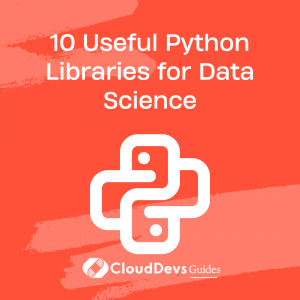How to use Python for Data Science
Python has been hailed as one of the most accessible and user-friendly languages for data science. Its popularity in the data science community isn’t just by chance but due to the powerful libraries, it offers.
This article is an overview of ten essential Python libraries that provide efficient and versatile tools for every data scientist.
1. NumPy (Numerical Python)
NumPy is perhaps the most fundamental library in Python for numerical computing. Its powerful N-dimensional array object allows for efficient computation with matrices, making it extremely suitable for solving mathematical and logical operations. The library supports a broad range of mathematical functions, including statistical, algebraic, and trigonometric operations. NumPy’s high-level mathematical functions are an essential foundation for many other Python libraries.
2. pandas
pandas is built on top of NumPy and is another must-have for data scientists. It provides data structures and functions needed to manipulate and analyze structured data. The DataFrame, pandas’ most critical data structure, is essentially a table (similar to an Excel sheet), making pandas perfect for tabular data analysis. Additionally, pandas provide excellent tools for data wrangling, including handling missing data, merging or reshaping datasets, and pivoting tables.
3. Matplotlib
Data visualization is crucial in data science, and Matplotlib is one of Python’s key libraries for this purpose. It’s a versatile library capable of creating static, animated, and interactive plots in many styles. With Matplotlib, you can create line plots, scatter plots, bar graphs, error charts, histograms, power spectra, and much more. Though the library may seem a bit complex for beginners, mastering it is an investment that pays off handsomely.
4. Seaborn
Seaborn is another Python visualization library based on Matplotlib. It provides a high-level interface for drawing attractive and informative statistical graphics. Seaborn comes with built-in themes for styling Matplotlib graphics and adds additional plot types. It also makes your visualizations more attractive and more informative, allowing for a more refined analysis and presentation of your data.
5. SciPy (Scientific Python)
SciPy is a library that uses NumPy for more mathematical problems. It’s a highly flexible library that includes modules for optimization, linear algebra, integration, interpolation, special functions, FFT, signal and image processing, ODE solvers, and other tasks common in science and engineering. In essence, SciPy fills in some gaps in NumPy’s capabilities.
6. Scikit-learn
Scikit-learn is a powerful library for machine learning in Python. It’s built on top of NumPy, SciPy, and Matplotlib. Scikit-learn provides simple and efficient tools for data mining and data analysis. It includes various classification, regression, clustering algorithms, and efficient tools for model fitting, data preprocessing, model selection, and evaluation.
7. TensorFlow
TensorFlow is an open-source library developed by Google Brain Team. It’s used for complex computations and has found significant applications in deep learning algorithms. It provides multiple APIs, the lowest of which is for conducting computations on graphical processing units (GPUs) and tensor processing units (TPUs). Its flexible architecture allows for the easy deployment of computation across a variety of platforms.
8. Keras
Keras is a user-friendly neural network library written in Python. It’s built as an interface for the TensorFlow library. Keras is highly modular and incredibly expressive, making it intuitive and user-friendly, perfect for beginners planning to delve into neural networks. It’s especially suitable for deep learning tasks and provides the necessary tools for building and training neural networks.
9. PyTorch
PyTorch, developed by Facebook’s artificial-intelligence research group, is another open-source machine learning library for Python. It’s based on Torch, a library written in C, and is designed for maximum flexibility and speed. PyTorch is popular for providing two of the most essential features for a regular system: tensor computations with GPU acceleration support and building deep neural networks on a tape-based autograd system.
10. LightGBM
LightGBM is a gradient boosting framework that uses tree-based learning algorithms. Developed by Microsoft, LightGBM can handle large size data and takes lower memory to run. This library is renowned for its speed and efficiency, with support for GPU learning and excellent accuracy. It’s a powerful tool when dealing with structured datasets.
Conclusion
In conclusion, these are only a fraction of the Python libraries available for data science, but they provide a solid foundation to start with. They cover a broad range of data science tasks from basic mathematical computations to advanced machine learning tasks. Each library has its strengths, so knowing when and how to use each one can make your data science projects more efficient and effective. Happy coding!
Table of Contents








